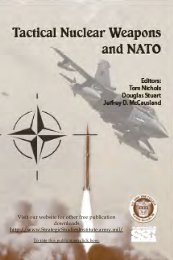Revisiting the Dove's Dilemma: - Program on Strategic Stability ...
Revisiting the Dove's Dilemma: - Program on Strategic Stability ...
Revisiting the Dove's Dilemma: - Program on Strategic Stability ...
Create successful ePaper yourself
Turn your PDF publications into a flip-book with our unique Google optimized e-Paper software.
Ericks<strong>on</strong> and Way, “Doves <str<strong>on</strong>g>Dilemma</str<strong>on</strong>g>”<br />
material means. States may not be c<strong>on</strong>tent, especially early <strong>on</strong> in <str<strong>on</strong>g>the</str<strong>on</strong>g> nuclear n<strong>on</strong>proliferati<strong>on</strong><br />
regime, to leave o<str<strong>on</strong>g>the</str<strong>on</strong>g>rs to change <str<strong>on</strong>g>the</str<strong>on</strong>g>ir practices in resp<strong>on</strong>se to social or legal pressure from<br />
internati<strong>on</strong>al instituti<strong>on</strong>s. The dove’s dilemma is not <strong>on</strong>ly an important and difficult choice, but<br />
also an instructive <strong>on</strong>e.<br />
Research Design and Data<br />
To assess whe<str<strong>on</strong>g>the</str<strong>on</strong>g>r countries pursuing nuclear weap<strong>on</strong>s enjoy increased access to major<br />
c<strong>on</strong>venti<strong>on</strong>al arms transfers, we estimate a series of statistical models of c<strong>on</strong>venti<strong>on</strong>al arms<br />
imports from 1960 to 2001. At present, we have data covering <str<strong>on</strong>g>the</str<strong>on</strong>g> nine largest arms exporters<br />
and 182 importers. 7 The following secti<strong>on</strong>s describe our dependent, independent, and c<strong>on</strong>trol<br />
variables, as well as expected relati<strong>on</strong>ships am<strong>on</strong>g <str<strong>on</strong>g>the</str<strong>on</strong>g>m.<br />
Dependent Variable: Major C<strong>on</strong>venti<strong>on</strong>al Weap<strong>on</strong>s Transfers<br />
Major c<strong>on</strong>venti<strong>on</strong>al weap<strong>on</strong>s (MCW) are defined as large weap<strong>on</strong>s with a military<br />
purpose, falling into <strong>on</strong>e of nine categories: aircraft, armored vehicles, artillery, sensors, air<br />
defense systems, missiles, ships, engines or an ―o<str<strong>on</strong>g>the</str<strong>on</strong>g>r‖ fulfilling specified qualificati<strong>on</strong>s (SIPRI<br />
2007: 428-29). We focus <strong>on</strong> major c<strong>on</strong>venti<strong>on</strong>al weap<strong>on</strong>s, ra<str<strong>on</strong>g>the</str<strong>on</strong>g>r than small and major<br />
c<strong>on</strong>venti<strong>on</strong>al weap<strong>on</strong>s, because MCW have historically been tools of major power foreign<br />
policy, symbols of prestige, and <str<strong>on</strong>g>the</str<strong>on</strong>g> stuff of c<strong>on</strong>venti<strong>on</strong>al arms races. In comparis<strong>on</strong>, small arms<br />
are lower-tech and were less politically important to importers and exporters until <str<strong>on</strong>g>the</str<strong>on</strong>g> advent of<br />
multilateral c<strong>on</strong>trol processes in <str<strong>on</strong>g>the</str<strong>on</strong>g> late-1990s and bey<strong>on</strong>d.<br />
7 We are in <str<strong>on</strong>g>the</str<strong>on</strong>g> process of expanding this to cover <str<strong>on</strong>g>the</str<strong>on</strong>g> top 15 exporters. The current nine exporters are (in no<br />
particular order): United States, Canada, United Kingdom, France, Spain, (West) Germany, Czechoslovakia/Czech<br />
Republic, Italy, and <str<strong>on</strong>g>the</str<strong>on</strong>g> Soviet Uni<strong>on</strong>/Russia.<br />
10








